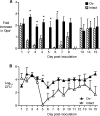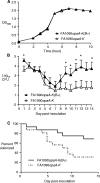Opacity proteins increase Neisseria gonorrhoeae fitness in the female genital tract due to a factor under ovarian control
- PMID: 20100859
- PMCID: PMC2849431
- DOI: 10.1128/IAI.00996-09
Opacity proteins increase Neisseria gonorrhoeae fitness in the female genital tract due to a factor under ovarian control
Abstract
The neisserial opacity (Opa) proteins are a family of antigenically distinct outer membrane proteins that undergo phase-variable expression. Opa(+) variants of Neisseria gonorrhoeae strain FA1090 are selected in a cyclical pattern from the lower genital tract of estradiol-treated mice. Here we show that cyclical recovery of Opa(+) gonococci does not occur in ovariectomized mice; therefore, the reproductive cycle plays a role in the selection kinetics in vivo. As predicted by the selection pattern shown by wild-type gonococci, we demonstrated that a constitutive Opa-expressing strain was more fit than an Opa-deficient mutant in the early and late phases of infection. We found no evidence that Opa-mediated colonization selects for Opa(+) variants during murine infection based on adherence assays with cultured murine epithelial cells. We also tested the hypothesis that complement selects for Opa protein expression during infection. Although some Opa(+) variants of a serum-sensitive derivative of strain FA1090 were more resistant to the bactericidal activity of normal human serum, selection for Opa expression was not abrogated in C3-depleted mice. Finally, as previously reported, Opa(+) gonococci were more sensitive to serine proteases. Thus, proteases or protease inhibitors may contribute to the observed in vivo selection pattern. We concluded that Opa proteins promote persistence of N. gonorrhoeae in the female genital tract and that opa gene phase variation allows gonococci to evade or capitalize upon unidentified host factors of the mammalian reproductive cycle. This work revealed an intimate interaction between pathogen and host and provides evidence that hormonally related factors shape bacterial adaptation.
Figures







Similar articles
-
In vivo selection for Neisseria gonorrhoeae opacity protein expression in the absence of human carcinoembryonic antigen cell adhesion molecules.Infect Immun. 2006 May;74(5):2965-74. doi: 10.1128/IAI.74.5.2965-2974.2006. Infect Immun. 2006. PMID: 16622235 Free PMC article.
-
Specific Binding to Differentially Expressed Human Carcinoembryonic Antigen-Related Cell Adhesion Molecules Determines the Outcome of Neisseria gonorrhoeae Infections along the Female Reproductive Tract.Infect Immun. 2018 Jul 23;86(8):e00092-18. doi: 10.1128/IAI.00092-18. Print 2018 Aug. Infect Immun. 2018. PMID: 29760215 Free PMC article.
-
Innate recognition by neutrophil granulocytes differs between Neisseria gonorrhoeae strains causing local or disseminating infections.Infect Immun. 2013 Jul;81(7):2358-70. doi: 10.1128/IAI.00128-13. Epub 2013 Apr 29. Infect Immun. 2013. PMID: 23630956 Free PMC article.
-
'Small' talk: Opa proteins as mediators of Neisseria-host-cell communication.Curr Opin Microbiol. 2003 Feb;6(1):43-9. doi: 10.1016/s1369-5274(03)00004-3. Curr Opin Microbiol. 2003. PMID: 12615218 Review.
-
Evasion mechanisms of pathogenic Neisseriae.Behring Inst Mitt. 1991 Feb;(88):194-9. Behring Inst Mitt. 1991. PMID: 1688359 Review.
Cited by
-
Neisseria gonorrhoeae suppresses dendritic cell-induced, antigen-dependent CD4 T cell proliferation.PLoS One. 2012;7(7):e41260. doi: 10.1371/journal.pone.0041260. Epub 2012 Jul 23. PLoS One. 2012. PMID: 22844448 Free PMC article.
-
Human Factor H Domains 6 and 7 Fused to IgG1 Fc Are Immunotherapeutic against Neisseria gonorrhoeae.J Immunol. 2018 Nov 1;201(9):2700-2709. doi: 10.4049/jimmunol.1701666. Epub 2018 Sep 28. J Immunol. 2018. PMID: 30266769 Free PMC article.
-
Opa+ Neisseria gonorrhoeae exhibits reduced survival in human neutrophils via Src family kinase-mediated bacterial trafficking into mature phagolysosomes.Cell Microbiol. 2015 May;17(5):648-65. doi: 10.1111/cmi.12389. Epub 2014 Nov 25. Cell Microbiol. 2015. PMID: 25346239 Free PMC article.
-
Gonorrhea - an evolving disease of the new millennium.Microb Cell. 2016 Sep 5;3(9):371-389. doi: 10.15698/mic2016.09.524. Microb Cell. 2016. PMID: 28357376 Free PMC article. Review.
-
Experimental Gonococcal Infection in Male Volunteers: Cumulative Experience with Neisseria gonorrhoeae Strains FA1090 and MS11mkC.Front Microbiol. 2011 May 31;2:123. doi: 10.3389/fmicb.2011.00123. eCollection 2011. Front Microbiol. 2011. PMID: 21734909 Free PMC article.
References
-
- Al-Suleiman, S. A., E. M. Grimes, and H. S. Jonas. 1983. Disseminated gonococcal infections. Obstet. Gynecol. 61:48-51. - PubMed
-
- Bhat, K. S., C. P. Gibbs, O. Barrera, S. G. Morrison, F. Jahnig, A. Stern, E. M. Kupsch, T. F. Meyer, and J. Swanson. 1991. The opacity proteins of Neisseria gonorrhoeae strain MS11 are encoded by a family of 11 complete genes. Mol. Microbiol. 5:1889-1901. - PubMed
Publication types
MeSH terms
Substances
Grants and funding
LinkOut - more resources
Full Text Sources
Other Literature Sources
Medical
Molecular Biology Databases
Research Materials
Miscellaneous

